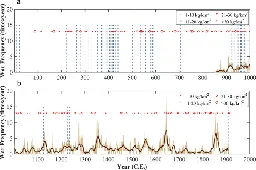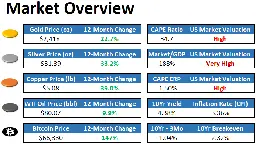at least it would probably build up some new ice and increase albedo, maybe set off a global cooling cycle
probably ADHD, scroll to the bottom for sources and look those up, thats what i usually do . the paper this is derived from was previously posted already
Bardeen, Charles G., Douglas E. Kinnison, Owen B. Toon, Michael J. Mills, Francis Vitt, Lili Xia, Jonas Jägermeyr et al. "Extreme ozone loss following nuclear war results in enhanced surface ultraviolet radiation." Journal of Geophysical Research: Atmospheres 126, no. 18 (2021): e2021JD035079. http://dx.doi.org/10.1029/2021JD035079
In a nuclear war, hundreds to thousands of detonations would occur within minutes, resulting in tens to hundreds of millions of people dead or injured in a few days. But a few years after, global climatic changes caused by the many nuclear explosions could be responsible for the death of more than h...

>The loss of the Earth’s protective ozone layer would result in several years of extremely high ultraviolet (UV) light at the surface, a hazard to human health and food production. Most recent estimates indicate that the ozone loss after a global nuclear war would lead to a tropical UV index above 35, starting three years after the war and lasting for four years. The US Environmental Protection Agency considers a UV index of 11 to pose an “extreme” danger; 15 minutes of exposure to a UV index of 12 causes unprotected human skin to experience sunburn. Globally, the average sunlight in the UV-B range would increase by 20 percent. High levels of UV-B radiation are known to cause sunburn, photoaging, skin cancer, and cataracts in humans. They also inhibit the photolysis reaction required for leaf expansion and plant growth.
✓ Canada’s per-capita productivity ranks among the highest in the world, though this is masked by US corporate owners’ use of transfer and ‘management’ fees to eliminate reported Canadian profits (and avoid paying any Canadian taxes)
Their economy is the biggest potemkin economy ive ever seen , all the metrics are skewed by pure bulllshit financialization and real estate ponzi with everyone selling houses back and forth to each other on crazy leverage with adjustable rate mortgages, its like 2007 there for the past 17 years without the big crash to bring the thing down, they just keep legislating ways to keep it going.
✓ protesting in Canada is mostly legal, though this freedom is being threatened ✓ the level of surveillance of citizen activity and behaviour remains tolerable, though this is changing, especially surveillance by foreign corporations and governments
bullshit they attacked and even seized and froze the bank accounts of the trucker protestors not that long ago. they have less freedom than the usa by a huge margin. ottawa is police state at the lightest protest they give bullshit charges to anyone present if they can find anything at all, like you forgot to replace your license plate bulb or have a old empty beer can near you
✓ we are extraordinarily privileged to be free from the imminent threat of war or invasion
canada government is the occupation , its a colony of britain , with an absolutely miserable underclass of indigenous people. the canadian gov is worse than the usa they just have better PR.
They are literally razing childrens playgrounds to install homeless encampments where they burn mostly plastic to stay warm it is insane.
USA citizens would work those jobs if they paid them a living wage. Labor costs are tiny fraction of food costs even tripling the prevailing ag labor wage would be trivial percent increases in the price of most food
6 in 10 struggle to “recognize and work with mathematical relationships, patterns, and proportions expressed in verbal or numerical form; and can interpret and perform basic analyses of data and statistics in texts, tables and graphs.”
The level 3 question , is what i would consider to be elementary school level. Only 37% of US Adults scored at Level ≥3
Are you not terrified?!
I always wondered how climate deniers could look at temperature and co2 level graphs then walk away with completely different reality than me... It turns out they are actually borderline mentally retarded and these people are a giant dangerous mob
When communicating data to 'the public,' how simple does it need to be? How much complexity can people handle?

TLDR idiocracy
with higher temps , it isnt a mystery how. it drives bacteria and fungi metabolic rates and activity they eat carbon and fart it out. plain simple and predicted decades ago
pretty sure everyone that title read that chuckled and said "semi?!?" incredulously
Not
This is one of my major metrics for measuring collapse, kind of scary its already happening and things aren't even bad yet
In 17th- to 20th-century England, the Lockeian idea that property should be made and held by the highest-value creators formed the justification for enclosure of the commons.
Thats not a lockeian idea. Locke was quite clear that private property was unjustifiable when there wasn't as much and as good available for everyone else.
supplement is good for getting more detailed ideas of what various scenarios look like for particular countries
A year ago I was reading a bunch of papers on biofortification via plant breeding and there was some really interesting info about just how many people can be shifted from inadequate to adequate intake of some nutrients just by breeding in things like higher levels of lysine, zinc, iron, beta carotene, etc.. into staple crops. In places like india and africa just replacing a handful of crops with improved varieties can shift hundreds of millions of people out of deficiency ranges that cause permanent cognitive and physical stunting/disability.
Overtime as trace mineral depletion continues in global cropland and as CO2 levels reduce nutrient density of crops purposeful breeding programs and soil repletion will be necessary to have decent health of previous generations
Down in Texas on gulf coast area, my friends panic buying a house but the mortgage is impossible unless the house is fully insured until it is paid off, the snag is that of all the insurers they called none would insure houses in this location and the house they are buying is not in flood zone and is not adjacent to any water. Big insurance is just straight abandoning huge areas and letting current policies fall off and not renewing
yeah investment will continue and they will extend this timeline but we find less and less which is more costly to extract. The real shock of this is just that the situation is very dire very quickly if the pace cannot keep up. If you consider that investment could cease substantially due to financial issues or the fact that high oil prices may not be sustainable. How fast this collapse can happens if something goes wrong is really the reason i posted this. the decline can be so fierce it would be a huge stagflationary trigger which is how most people will experience this.
Previously, I remember you saying that the average person will start to feel very affected by the energy crunch starting sometime in the 2030’s and that the level of collapse will continue to increase for maybe a few decades after that.
I was probably talking about total energy including natural gas, because natural gas peak estimates come in around 2034, after that its crucial we have built out alternatives sufficiently to at least put a floor beneath us in terms of electrical generation. Its still possible we can get enough build out to at least keep functioning as depletion kicks in but we are currently not aggressive enough with installing renewable or nuclear capacity.
Our Outlook reflects oil production naturally declining at a rate of about 15% per year. That’s nearly double the IEA’s prior estimates of about 8%. This increase is the result of the world’s shifting energy mix toward “unconventional” sources of oil and natural gas. These are mostly shale and dense rock formations where oil and gas production typically declines faster. To put it in concrete terms: With no new investment, global oil supplies would fall by more than 15 million barrels per day in the first year alone. At that rate, by 2030, oil supplies would fall from 100 million barrels per day to less than 30 million – that’s 70 million barrels short of what’s needed to meet demand every day.
The world would experience severe energy shortages and disruption to daily lives within a year of investment ceasing. Given price responses to past oil supply shocks, the permanent loss of 15% of oil supply per year could raise oil prices by more than 400%. By comparison, prices rose 200% during the oil price shocks of the 1970s. Within 10 years, unemployment rates would likely reach 30%. That’s higher than during the Great Depression of the 1930s.
https://corporate.exxonmobil.com/-/media/global/files/global-outlook/2024/global-outlook-executive-summary.pdf
https://corporate.exxonmobil.com/sustainability-and-reports/global-outlook#ExploretheGlobalOutlook
The relationships between the use of agricultural inputs and crop yields are complex. This study presents a machine learning model to predict the changes in crop yield in the face of single and combined agricultural input shocks and shows that shocks in the availability of commercial agricultural in...

lots of good maps and info in this one.
given that Edo era Japan did not have biofuels
Wood is biofuel.
to summarize in a different way the arguments of the person you are debating with i would say just look around you, how much have we weaned from fossil fuels.
in 1993 the sum of nuclear and renewables in our global energy mix was 14%, 30 years later in 2023 it is 18.5%. our total energy usage is massively higher and fossil fuel use is massively higher over those 30 years.
Its too little too late scenario. Sure its technically possible we could replace FFs with renewables and nuclear but thats not where we are at yet or in the next 50 years at this pace. Now depending on what you think the depletion curve of FFs looks like will tell you if it will be possible or not. the data doesnt look good for a smooth transition. At best the scenario is a severe bottleneck unless we pull some unprecedented exponential changes in renewable and nuclear deployment.
https://archive.is/Hy1fX
>In particular, food production has collapsed in the country. Alexis Rodríguez Pérez, a senior official at the Ministry of Agriculture, said the country produced 15,200 tons of beef in the first six months of this year. As a comparison, Cuba produced 172,300 tons of beef in 2022, already down 40% from 289,100 in 1989. Pork production fared even worse. The country produced barely 3,800 tons in the first six months of this year, compared to 149,000 tons in all of 2018.
https://archive.is/Hy1fX
>In particular, food production has collapsed in the country. Alexis Rodríguez Pérez, a senior official at the Ministry of Agriculture, said the country produced 15,200 tons of beef in the first six months of this year. As a comparison, Cuba produced 172,300 tons of beef in 2022, already down 40% from 289,100 in 1989. Pork production fared even worse. The country produced barely 3,800 tons in the first six months of this year, compared to 149,000 tons in all of 2018.
I stayed in lousiana near the gulf for a while and passed through there a few times over the past 5 years. Its incredible how much of the stuff never rebuilt, not just from katrina but all the damage since in multiple cities just entire areas where 60% of the houses have blue tarps on the roofs and knocked over trees and collapsed sheds/fences never dealt with. It gets noticeably worse each time i pass through. It is not all just the poorest areas either, its areas where you would think people would have insurance coverage but at this point insurance is falling into "discretionary" spending category as people need to just buy necessities and hope for the best. there are parts that look like post-collapse movie or something where people just do whatever makeshift ghetto rigged patches and stay.
let me know if chart shows up. its not working for me for some reason, other mods delete post if im not awake to deal with it after confirming no chart visible to anyone else either
queue AENIMA background track
Heavy subsidies have made wind turbines a growing share of electricity in developed countries. But since wind cannot meet the needs of modern industry, it will contribute to deindustrialization.

@leashless: People love to make this shit complicated. It's a profession. It's not complicated: we're using *far too much stuff* because we have no design discipline for "human satisfaction with minimal footprint" a...…

Ray Dalio writes about the five big, interrelated forces that drive how domestic and world orders change

Decline in wheat production over the past two seasons because of rising temperatures has reduced domestic availability

On when the modern world was invented

https://www.aphis.usda.gov/livestock-poultry-disease/avian/avian-influenza/hpai-detections/livestock
Table of Contents Theme issue ‘Climate change adaptation needs a science of culture’ compiled and edited by Anne C. Pisor, J. Stephen Lansing and Kate Magargal Whether we’re facing job loss or extreme climate events, people use cultural solutions to manage risk. By studying the solutions people use to deal with climate change, researchers learn which solutions tend to emerge given different conditions—like local geography, structural constraints, or kinds of extreme event. This theme issue brings together articles from prominent researchers to document what solutions communities have used, past and present; whether these solutions worked or not; and why. Understanding how climate change adaptation unfolds will help researchers, policymakers, and organizations better support communities as they respond.
A collection of data sets associated with this issue can be found here on the Dryad digital repository.
Read a blog post about the theme issue from one of the Guest Editors.
This issue is available to buy in print. Visit our information for readers page for purchasing options.
INTRODUCTION
Introduction Climate change adaptation needs a science of culture Anne Pisor, J. Stephen Lansing and Kate Magargal Published:18 September 2023Article ID:20220390 https://doi.org/10.1098/rstb.2022.0390
Abstract Full text PDF References Preview Abstract PART I: MICRO
Research articles Climate micro-mobilities as adaptation practice in the Pacific: the case of Samoa Anita Latai-Niusulu, Masami Tsujita and Andreas Neef Published:18 September 2023Article ID:20220392 https://doi.org/10.1098/rstb.2022.0392
Abstract Full text PDF References Preview Abstract
Research articles The impacts of climate change, energy policy and traditional ecological practices on future firewood availability for Diné (Navajo) People Kate Magargal, Kurt Wilson, Shaniah Chee, Michael J. Campbell, Vanessa Bailey, Philip E. Dennison, William R. L. Anderegg, Adrienne Cachelin, … See all authors Published:18 September 2023Article ID:20220394 https://doi.org/10.1098/rstb.2022.0394
Abstract Full text PDF References Preview Abstract
Research articles Socio-economic predictors of Inuit hunting choices and their implications for climate change adaptation Friederike Hillemann, Bret A. Beheim and Elspeth Ready Published:18 September 2023Article ID:20220395 https://doi.org/10.1098/rstb.2022.0395
Abstract Full text PDF References Preview Abstract
Research articles Small-scale farmer responses to the double exposure of climate change and market integration K. L. Kramer and J. V. Hackman Published:18 September 2023Article ID:20220396 https://doi.org/10.1098/rstb.2022.0396
Abstract Full text PDF References Preview Abstract
Research articles Understanding constraints to adaptation using a community-centred toolkit Danielle C. Buffa, Katharine E. T. Thompson, Dana Reijerkerk, Stephanie Brittain, George Manahira, Roger Samba, Francois Lahiniriko, … See all authors Published:18 September 2023Article ID:20220391 https://doi.org/10.1098/rstb.2022.0391
Abstract Full text PDF References Preview Abstract PART II: MESO
Research articles Operationalizing cultural adaptation to climate change: contemporary examples from United States agriculture Timothy M. Waring, Meredith T. Niles, Matthew M. Kling, Stephanie N. Miller, Laurent Hébert-Dufresne, Hossein Sabzian, Nicholas Gotelli and Brian J. McGill Published:18 September 2023Article ID:20220397 https://doi.org/10.1098/rstb.2022.0397
Abstract Full text PDF References Preview Abstract
Research articles Adaptive irrigation management by Balinese farmers reduces greenhouse gas emissions and increases rice yields J. S. Lansing, J. N. Kremer, I. B. G. Suryawan, S. Sathiakumar, G. S. Jacobs, N. N. Chung and I. Wy A. Artha Wiguna Published:18 September 2023Article ID:20220400 https://doi.org/10.1098/rstb.2022.0400
Abstract Full text PDF References Preview Abstract
Research articles Minority-group incubators and majority-group reservoirs support the diffusion of climate change adaptations Matthew A. Turner, Alyson L. Singleton, Mallory J. Harris, Ian Harryman, Cesar Augusto Lopez, Ronan Forde Arthur, Caroline Muraida and James Holland Jones Published:18 September 2023Article ID:20220401 https://doi.org/10.1098/rstb.2022.0401
Abstract Full text PDF References Preview Abstract PART III: MACRO
Research articles Navigating polycrisis: long-run socio-cultural factors shape response to changing climate Daniel Hoyer, James S. Bennett, Jenny Reddish, Samantha Holder, Robert Howard, Majid Benam, Jill Levine, Francis Ludlow, Gary Feinman and Peter Turchin Published:18 September 2023Article ID:20220402 https://doi.org/10.1098/rstb.2022.0402
Abstract Full text PDF References Preview Abstract
Research articles Efficiency traps beyond the climate crisis: exploration–exploitation trade-offs and rebound effects Jose Segovia-Martin, Felix Creutzig and James Winters Published:18 September 2023Article ID:20220405 https://doi.org/10.1098/rstb.2022.0405
Abstract Full text PDF References Preview Abstract
Review articles Climate change and long-term human behaviour in the Neotropics: an archaeological view from the Global South Vivian Scheinsohn, A. Sebastián Muñoz and Mariana Mondini Published:18 September 2023Article ID:20220403 https://doi.org/10.1098/rstb.2022.0403
Abstract Full text PDF References Preview Abstract PART IV: CLOSING
Opinion piece Climate change adaptation and the back of the invisible hand H. Clark Barrett and Josh Armstrong Published:18 September 2023Article ID:20220406 https://doi.org/10.1098/rstb.2022.0406
As any long-time reader of this column knows, we routinely draw from historical lessons to highlight that this time is not different. Throughout the 18th century, for example, France was the greatest…

https://www.sciencedirect.com/science/article/pii/S0921800914000615
Collapses of China’s ruling dynasties were associated with explosive volcanic eruptions over the past two millennia, with the degree of influence depending on pre-existing stress in society, as suggested by a systematic analysis of eruptions and Chinese warfare.

State or societal collapses are often described as featuring rapid reductions in socioeconomic complexity, population loss or displacement, and/or political discontinuity, with climate thought to contribute mainly by disrupting a society’s agroecological base. Here we use a state-of-the-art multi-ice-core reconstruction of explosive volcanism, representing the dominant global external driver of severe short-term climatic change, to reveal a systematic association between eruptions and dynastic collapse across two millennia of Chinese history. We next employ a 1,062-year reconstruction of Chinese warfare as a proxy for political and socioeconomic stress to reveal the dynamic role of volcanic climatic shocks in collapse. We find that smaller shocks may act as the ultimate cause of collapse at times of high pre-existing stress, whereas larger shocks may act with greater independence as proximate causes without substantial observed pre-existing stress. We further show that post-collapse warfare tends to diminish rapidly, such that collapse itself may act as an evolved adaptation tied to the influential “mandate of heaven” concept in which successive dynasties could claim legitimacy as divinely sanctioned mandate holders, facilitating a more rapid restoration of social order.
Climate variability and natural hazards like floods and earthquakes can act as environmental shocks or socioecological stressors leading to instability and suffering throughout human history. Yet, societies experience a wide range of outcomes when facing such challenges: some suffer from social unrest, civil violence or complete collapse; others prove more resilient and maintain key social functions. We currently lack a clear, generally agreed-upon conceptual framework and evidentiary base to explore what causes these divergent outcomes. Here, we discuss efforts to develop such a framework through the Crisis Database (CrisisDB) programme. We illustrate that the impact of environmental stressors is mediated through extant cultural, political and economic structures that evolve over extended timescales (decades to centuries). These structures can generate high resilience to major shocks, facilitate positive adaptation, or, alternatively, undermine collective action and lead to unrest, violence and even societal collapse. By exposing the ways that different societies have reacted to crises over their lifetime, this framework can help identify the factors and complex social–ecological interactions that either bolster or undermine resilience to contemporary climate shocks.
The Indian Vulture Crisis, sky burials and the end of the oldest religion?

There may not even be enough vultures to eat our corpses at the end of the world.
May 19, 2024 The topic for this issue focuses on when and how the bond market lost its predictive power regarding the economy and inflation. This is relevant because the bond market is enormous, and serves as a core asset class for central banks and for investment portfolios. Recently published cont...


